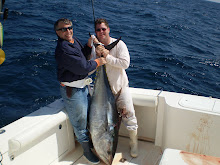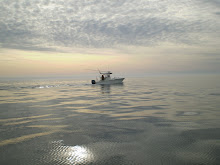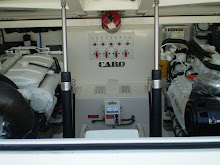 By Jim Field
By Jim FieldJust two months and four years ago (April 2006), Dan, Uncle John, and I took the
Sea Ya Bea south to Cape Hatteras for the first time. Dan and I had been fishing together for more than a year by then, and saw in each other a love of the sport and interest in trying different things. Uncle John was someone new to me, married to Dan's Aunt Chrissie and a sportfisherman going back to the 1960s-1970s, when the norm (for some) had been to take small, single-engine center consoles far, far offshore--no Loran, no GPS, no life raft, one radio (yet courage and fortitude a must). Being new to deep sea fishing, I knew nothing of Hatteras and its renown as perhaps the best sportfishing waters in the world. To me, Hatteras meant Nags Head, Duck, beaches, lotion, and swimming--that was all. Dan, on the other hand, a long-time fisherman, knew what went on in Hatteras, and, after one of our fishing trips the previous summer, suggested that we should take the
Sea Ya Bea down there and give it a try and check things out.
In the moment, we agreed this would be great: "Let's do it! Wouldn't that be incredible? We need to break out of Delaware and give it a go!" Of course, with a few beers under the belt, and the beauty of a day on the water still casting a residual glow, fishermen tend to think grand thoughts, plan grand schemes, and then......forget about them entirely once back to work and life's routines. It all sounds great in theory; it makes one feel free, to exercise the illusory ability to live life boldly on a whim; but then reality sinks in (takes no more than 5 minutes), slamming the door shut on such ridiculous, ludicrous thoughts.
Lights, camera, action!
Sinking a pointed finger into their chests, Reality says to the boys: "Who the hell are you to think you can do this kind of thing? Get back in line, you peasants, you slaves, you low-lifes, maybe someday you'll do this (ah, not really), but it's not going to be anytime soon. Crawl back into your boxes like good adults, and shut up! Now! Before I really lose my temper!"But, for whatever reasons and circumstances (fate, karma, planets/stars aligning themselves in the universe???), this time around, across the next few months, this one particular hypothetical proposal didn't drift away, but rather got caught up in our minds and conversations (like leader wrapped around a prop), and by refusing to go away, slowing embedded itself as something
we were actually going do.
At some point, Dan and I set a date, and Dan recruited Uncle John. Then "the date" became a whole week that we would set aside to make the journey, as we would need a buffer given the unpredictability of good weather. We shook hands, committed ourselves to our mates and idea, and went about our business, waiting for the weeks and months to pass until our "expedition" would begin.
(One thing that escapes me now: where were the wives in all this? Can't believe we were so bold as to ask for a whole week off! What were we thinking?!!!)(Whatever it was: we need some of this mojo back!!!)(Can you believe we attempted this trip thinking we would get a 4-5 day window of good weather? This rarely happen! About as frequently as back-to-back good summiting days on Everest. But it worked out, showing the fishing God loves dummies (occassionally).)

Well, the days and weeks passed by--like in the old movies where the wind blows the pages away--and we gathered at Bethany for the trip South. Only one problem--the weather wasn't cooperating. A front was passing through, and the wind and seas were inhospitable. Thus we'd have to wait it out. We bunked down in Jim/Diane's beach house in Bethany proper, and proceeded to eat and watch movies to pass the time. (The photograph from the house's balcony attests to the gathering storm.) We had the
Sea Ya Bea all ready to go, so we had nothing else to do. After dinner, we spread out on the floor to watch movies--we hadn't furnished the family room yet; inevitably, before we'd get through the opening credits, Uncle John was out cold--sawing some big, big, logs.
After two days on the dole, the forecast cleared and we decided to go for it. We departed Indian River with first light and turned right (South) out of the breakwater, setting course for a waypoint off of Ocean City inlet. With OC's amusement park easily within sight, we refined our course and drew a line directly to the Point--a magical spot of fishing water SSE of Oregon Inlet, NC. Passing the mouth of the Chesapeake Bay (off Norfolk, Virginia Beach, and the Bridge-Tunnel), we were 50 miles out. Upon reaching the Point, we had caught up with the tailing weather and found ourselves among swells (termed "rollers") with gigantic shoulders--maybe 20 feet high, but benign due to being 20-30 seconds apart. I remember us shutting down from cruising speed, deploying fishing gear, with Uncle John in the cockpit framed by towering waves behind him. Beautiful deep blue waves. I also recall encountering a merchant ship--a container carrier--laboring in the seas and being fascinated by its motion and the surrounding colors. At some point, I went below to take a nap, and was awakened by a loud bang--we had hit something. I went topside at the same time that we got a fish on--line peeling off the reel. I was invited to take the rod and we brought a medium sized mahi-mahi onboard. We apparently had hit a floating pine 2x4, which the mahi was parked under.
With one fish in the box, and the afternoon hours (and daylight) marching on, we picked up gear and headed for Hatteras Inlet. We steamed another 40 miles South and then navigated another 25 miles NNW and then NNE around Diamond Shoals and Hatteras lighthouse. Approaching the inlet, we had been forewarned about its difficulty: perpetually shifting sands, sand and rock reefs, the potential for big waves in the inlet itself if tide and winds were going against each other--in other words, there was a real possibility of going aground. Feeling our way, we observed the ferrys shuttling passengers and vehicles to the next island and fell in behind some other fishing vessels entering the Hatteras marinas. We tied up at Oden's dock--one of four marinas for private boats. Our Dan had arranged things with Dan Oden, the current member of the Oden family with a big hand in running their various Outer Banks businesses.
All told, the day's trip from slip-to-slip had taken us 11 hours. Our cruising speed averaged 25 knots (pretty darn good). We burned about 350 gallons of diesel (from a 400 gallon tank). We transited roughly 230 nautical miles. And we had arrived safely.
That evening we spent our first night (of many to come) as guests in the Breakwater Motel--also owned by the Odens and located right behind the boat slips. We could look outside our room from the balcony and observe the
Sea Ya Bea at rest. Next morning we fished all day, trolling, and caught and released 18 small tuna. No keepers but busy all the time--so a great day. The day after we trolled again and saw tons of nature--I recall watching mahis flying through the air in huge archs--but we effectively got skunked, almost hooking up in the final seconds with a keeper tuna. Ironically, on this day the ocean was flat calm--glass-like--and here I learned that while flat sea conditions are good for stomachs, they're terrible for fishing, the best fishing days being characterized by 1-3 foot waves and 5-10 knots of wind. In short, the surface waters have to be interesting. (During this first trip we were clueless about the world-class bottom fishing in Hatteras--had we known this, Dan would have never let us troll.) Dinners, by the way, after fishing were good; on this first trip we discovered Dinki's, which we return to religiously. (There are only 2-4 restaurants open n Hatteras Village in the off-season.)
Inevitably, and all too soon for the three of us, the day came to return home. The morning of our departure was absolutely beautiful. We transited back to Delaware without problems/issues, and tied up on B dock in Indian River marina around 4:00 pm.
What had we found, and what had we learned? Well, we demonstrated that we could take voyages beyond Delaware and Maryland waters and return alive; the world indeed is round. We discovered NC fishing and, in particular, fishing in the Gulf Stream with its abundance of sea life, big game fish, and warm deep-blue crystal-clear water--water that you never see up North. And we were introduced to Hatteras Village, recognizing even on this first encounter that it was a very special place for fishing, beaches, and outdoor living and hunting. I'll give us credit--we knew something spectacular when we saw it and it didn't take long for us to figure this out.
At the time, and in retrospect, all three of us viewed our adventure as a fantastic trip. It was fun--and different--and not something everyone was doing, at least the fishermen we knew. But admittedly, there was a big downside to our journey, and that was that we now wanted to go back: immediately. Having tasted it, we wanted more. But unfortunately, a return wasn't in the cards anytime soon, and maybe never. Alas, better to have experienced it once than never. Bull! We had to go back! But how? And when? And how long would be have to wait?
Uncle John at his fishing station, vigilant like all good fishermen (His footprints are now bronzed on deck as a memorial)
 The mahi produced by hitting the board near the Point
The mahi produced by hitting the board near the Point Oden's Dock with Sea Ya Bea moored (at center)
Oden's Dock with Sea Ya Bea moored (at center)
 Minutes from casting off for Delaware. Miss Hatteras clients look on. Uncle John serenades them by whistling Beethoven's 5th
Minutes from casting off for Delaware. Miss Hatteras clients look on. Uncle John serenades them by whistling Beethoven's 5th Back at Indian River DE safely. Jim and Uncle John have a "cold one"
Back at Indian River DE safely. Jim and Uncle John have a "cold one" Dan and Uncle John, a great pairing to fish with
Dan and Uncle John, a great pairing to fish with Dan and Jim: One adventure accomplished--with more to follow
Dan and Jim: One adventure accomplished--with more to follow




































.jpg)


























